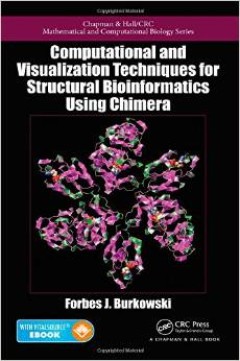Filter by

Distancenet:inferring Evolutionary Distances Using A Neural Network
Phylogenetic distance estimation between taxa in a tree is critical for tree reconstruction. There exist several classical methods that are already established in the field of phylogenetics. However, these classical methods of distance estimation are not straightforward and their computation can be tedious. As neural networks show great success in pattern recognition tasks, it is reasonable tha…
- Edition
- -
- ISBN/ISSN
- -
- Collation
- -
- Series Title
- -
- Call Number
- EP BI-003

Molecular evolutionary models in drug discovery
- Edition
- -
- ISBN/ISSN
- 9780128176139
- Collation
- xii, 179 p. : ill. : ind. ; 23 cm.
- Series Title
- -
- Call Number
- 615.19 Bue m
- Edition
- -
- ISBN/ISSN
- 9780128176139
- Collation
- xii, 179 p. : ill. : ind. ; 23 cm.
- Series Title
- -
- Call Number
- 615.19 Bue m

Coming to life : how genes drive development
Coming to Life is a remarkable journey through developmental biology that reveals miraculous processes in the microscopic world of cells. Through an accounting of groundbreaking discoveries, Christiane Nüsslein-Volhard tells us many answers to historical and contemporary questions in science. For example, she brings us the newest knowledge about embryonic forms, explains the genetic mechanisms…
- Edition
- -
- ISBN/ISSN
- 9780979845604
- Collation
- xiii, 166 p. : ill. : ind. ; 23 cm.
- Series Title
- -
- Call Number
- 576.5 Nus c

Modern phylogenetic comparative methods and their application in evolutionary…
Phylogenetic comparative approaches are powerful analytical tools for making evolutionary inferences from interspecific data and phylogenies. The phylogenetic toolkit available to evolutionary biologists is currently growing at an incredible speed, but most methodological papers are published in the specialized statistical literature and many are incomprehensible for the user community. This te…
- Edition
- -
- ISBN/ISSN
- 9783662435496
- Collation
- 552 p. : ill. : ind. ; 24 cm
- Series Title
- -
- Call Number
- 575 Mod

Molecular evolution
This text describes the dynamics of evolutionary change at the molecular level, the driving forces behind the evolutionary process, and the effects of the various molecular mechanisms on the structure of genes and genomes. It also explains the methodology involved in dealing with molecular data.
- Edition
- -
- ISBN/ISSN
- 0878934634
- Collation
- xv, 487 p. : ill. : ind. ; 26 cm.
- Series Title
- -
- Call Number
- 572.838 Wen m

Molecular evolution : a phylogenetic approach
The study of evolution at the molecular level has given the subject of evolutionary biology a new significance. Phylogenetic 'trees' of gene sequences are a powerful tool for recovering evolutionary relationships among species, and can be used to answer a broad range of evolutionary and ecological questions. They are also beginning to permeate the medical sciences. In this book, the authors app…
- Edition
- -
- ISBN/ISSN
- 9780865428898
- Collation
- v, 346 p. : ill. : ind. ; 25 cm.
- Series Title
- -
- Call Number
- 572.838 Pag m

Fundamentals of molecular evolution
This book describes the dynamics of evolutionary change at the molecular level, the driving forces behind the evolutionary process, the effects of the various molecular mechanisms on the structure of genes, proteins, and genomes, the methodology involved in dealing with molecular data from an evolutionary perspective, and the logic of molecular hypothesis testing. The Second Edition incorporate…
- Edition
- 2nd
- ISBN/ISSN
- 9780878932665
- Collation
- xiv, 481 p. : ill. : ind. ; 24 cm.
- Series Title
- -
- Call Number
- 572.838 Gra f

Computational molecular evolution
Computational Molecular Evolution provides an up-to-date and comprehensive coverage of modern statistical and computational methods used in molecular evolutionary analysis, such as maximum likelihood and Bayesian statistics. Yang describes the models, methods and algorithms that are most useful for analysing the ever-increasing supply of molecular sequence data, with a view to furthering our un…
- Edition
- -
- ISBN/ISSN
- 9780198567028
- Collation
- xvi, 357 p. : ill. : ind. ; 24 cm.
- Series Title
- -
- Call Number
- 572.8 Zih c

Bioinformatics and molecular evolution
In the current era of complete genome sequencing, Bioinformatics and Molecular Evolution provides an up-to-date and comprehensive introduction to bioinformatics in the context of evolutionary biology. This accessible text: provides a thorough examination of sequence analysis, biological databases, pattern recognition, and applications to genomics, microarrays, and proteomics emphasizes the theo…
- Edition
- -
- ISBN/ISSN
- 9781405106832
- Collation
- xiii, 365 p. : ill. : ind. ; 25 cm.
- Series Title
- -
- Call Number
- 572.8 Hig b

Computational and visualization techniques for structural bioinformatics usin…
A Step-by-Step Guide to Describing Biomolecular Structure Computational and Visualization Techniques for Structural Bioinformatics Using Chimera shows how to perform computations with Python scripts in the Chimera environment. It focuses on the three core areas needed to study structural bioinformatics: biochemistry, mathematics, and computation. Understand Important Concepts of Structura…
- Edition
- -
- ISBN/ISSN
- 9781439836613
- Collation
- xxv, 419 p. : ill. : ind. ; 24 cm.
- Series Title
- -
- Call Number
- 572.330285 Bur c

Recombinatorics : the algorithmics of ancestral recombination graphs and expl…
In this book, Dan Gusfield examines combinatorial algorithms to construct genealogical and exact phylogenetic networks, particularly ancestral recombination graphs (ARGs). The algorithms produce networks (or information about networks) that serve as hypotheses about the true genealogical history of observed biological sequences and can be applied to practical biological problems. Phylogeneti…
- Edition
- -
- ISBN/ISSN
- 9780262027526
- Collation
- xvii, 580 p. : ill. : ind. ; 24 cm.
- Series Title
- -
- Call Number
- 572.877 Gus r

Molecular evolution and phylogenetics
During the last ten years, remarkable progress has occurred in the study of molecular evolution. Among the most important factors that are responsible for this progress are the development of new statistical methods and advances in computational technology. In particular, phylogenetic analysis of DNA or protein sequences has become a powerful tool for studying molecular evolution. Along with th…
- Edition
- -
- ISBN/ISSN
- 9780195135855
- Collation
- xiv, 333 p. : ill. : ind. ; 27 cm.
- Series Title
- -
- Call Number
- 572.838 Nei m

Molecular evolution : a statistical approach
Studies of evolution at the molecular level have experienced phenomenal growth in the last few decades, due to rapid accumulation of genetic sequence data, improved computer hardware and software, and the development of sophisticated analytical methods. The flood of genomic data has generated an acute need for powerful statistical methods and efficient computational algorithms to enable their e…
- Edition
- 1st edition
- ISBN/ISSN
- 9780199602612
- Collation
- xv, 492 p. : ill. : ind. ; 26 cm
- Series Title
- -
- Call Number
- 572.838 Zih m

Evolution : an introduction
The second edition of Evolution introduces the basic mechanisms of microevolution, natural selection, and macroevolutionary processes such as speciation and extinction. It also examines key events in evolution throughout the geological record and discusses coevolution and evolutionary medicine. In addition, the text discusses unsolved problems and looks ahead to future developments in this dyna…
- Edition
- 2nd
- ISBN/ISSN
- 9780199255634
- Collation
- xx, 575 p. : ill. : ind. ; 25 cm.
- Series Title
- -
- Call Number
- 576.8 Ste e

Animal evolution : interrelationships of the living phyla
Animal Evolution provides a comprehensive analysis of the evolutionary interrelationships and myriad diversity of the Animal Kingdom. It reviews the classical, morphological information from structure and embryology, as well as the new data gained from studies using immune stainings of nerves and muscles and blastomere markings which makes it possible to follow the fate of single blastomeres al…
- Edition
- 3rd edition
- ISBN/ISSN
- 9780199606030
- Collation
- x, 402 p. : ill. : ind. ; 26 cm.
- Series Title
- -
- Call Number
- 591.38 Nie a

The genetics and biology of sexual conflict
The genetic interests of males and females often diverge; traits favored by one sex can be costly to the other. Over time, this "battle of the sexes," or sexual conflict, has important evolutionary consequences (e.g., speciation). Written and edited by experts in the field, this collection from Cold Spring Harbor Perspectives in Biologyexamines the underlying biology of sexual conflict-from th…
- Edition
- -
- ISBN/ISSN
- 9781621820598
- Collation
- xi, 414 p. : ill. : ind. ; 26 cm.
- Series Title
- -
- Call Number
- 591.4'6 Gen
 Computer Science, Information & General Works
Computer Science, Information & General Works  Philosophy & Psychology
Philosophy & Psychology  Religion
Religion  Social Sciences
Social Sciences  Language
Language  Pure Science
Pure Science  Applied Sciences
Applied Sciences  Art & Recreation
Art & Recreation  Literature
Literature  History & Geography
History & Geography